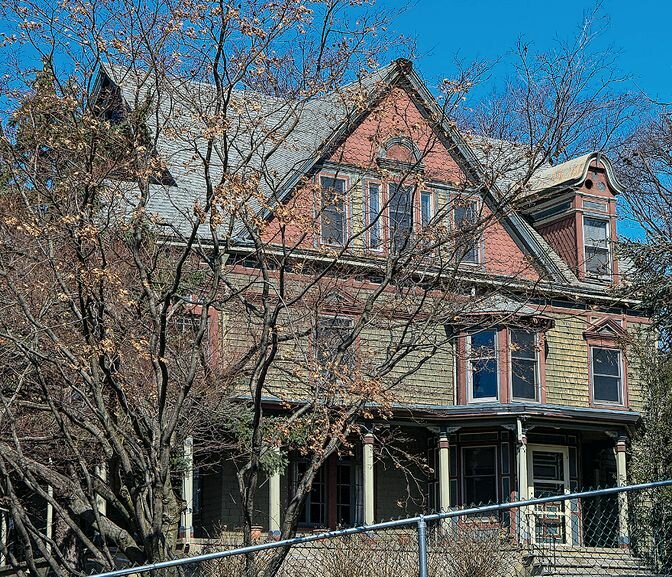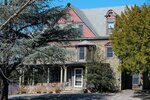Historic Riverdale house discovery highlights unrecognized colonial era landmark
While on paternity leave, Nick Dembowski, president of the Kingsbridge Historical Society, made a unexpected discovery — one of Riverdale’s oldest and largely unknown houses.
During his son’s naps, Dembowski immersed himself in research, examining old maps, land deeds and wills of early area residents. He soon noticed a small dot on a more recent map aligned perfectly to a home site on a much older map.
The house, Dembowski realized, was situated on the Hebrew Home senior living facility’s campus — a property acquired by the facility in 2011. Though this kind of discovery was not new to him, the significance of this find grew when later, a historical society member informed Dembowski the house was slated for demolition due to its “deteriorating” state, as revealed in a community board meeting.
The plan to demolish this house appeared to be a relatively last-minute modification to the Hebrew Home’s development plans, made after the environmental review, archeological review and zoning permit application had been completed — changes Dembowski believes may have sealed the house’s fate.
Despite its age and historical ties, Dembowski said this house has not been landmarked or even widely recognized for its significance. Known simply as “the Victorian home,” it lacks the formal designation typical to other local historic sites, such as Wave Hill.
Dembowski’s research revealed the house dates back to at least the 1780s and was once owned by John Warner, a local militia captain during the American Revolution. He was the second captain to hold this post, as the first turned out to be a secret agent for the British. Warner inherited the property from his father, William, indicating the house had been in the family for at least a generation before the revolution.
Warner’s election as a militia captain was uncommon for the time, suggesting he was a well-respected member of society. The house is also tied to the area’s history of slavery, as it was home to enslaved people, a history it shares with other notable properties in the region, such as the Van Cortlandt House.
Dembowski said there were two archaeological reports commissioned when the Hebrew Home acquired the property, but neither investigated the period before 1840.
“Probably because this information is very difficult to obtain,” he suggested.
The older maps he managed to unearth were from the Bronx topographical division, a little office in the county courthouse that houses some of the area’s earliest maps, gifted by the Westchester County archives. One map, which proved central to Dembowski’s discovery, was drawn with precise detail and accuracy.
“If the archaeological report said the building was built in 1840,” Dembowski said, “and this [map] is from 1837 and shows the building, then it led me to believe, wow, they really missed something here.”
Dembowski also suggested the map would likely have been drafted only after the house’s owner at the time died, which means the structure could date back to at least 1781. Currently, the Hadley House is recognized as the oldest house in the Bronx, but Dembowski believes, although there may be no way to definitely prove the Victorian house’s seniority, it dates to around the same period.
He anticipates discerning viewers might challenge the house’s age as a colonial-era residence due to its Victorian features. However, Dembowski said, it’s common for buildings to be added to over the years. While the contemporary map displays the house as two small rectangles, the original appears as one. Dembowski suspects the owner in the 1800s bought the old farmhouse from John Warner, then renovated it in the Victorian style and later expanded it.
According to a representative from the Hebrew Home, no one has lived in the Victorian home in the 10 years since it was purchased.
While the historical society’s primary goal is to raise awareness of the house’s history, Dembowski said the house could be repurposed in a way that enhances the Hebrew Home’s appeal. Potential uses include converting the house into a museum, a bed and breakfast for visiting seniors’ relatives, or even office space.
This issue is particularly relevant to the community as the neighborhood is located in the Special Natural Area District, which designates zoning requirements that typically allow for only single-family homes to be built. Though the Hebrew Home’s permitted plans for larger buildings in the area do not align with these zoning requirements, Dembowski believes neighbors have been willing to grant exceptions to the Hebrew Home as it is fulfilling an important and necessary role. However, a situation like this would usually involve a more negotiated process with the community.
Ultimately, Dembowski said he has great respect for the work of the Hebrew Home, but if the Victorian house were demolished, it would represent another loss of a link to the area’s past.
“What I consider my mission is to let this community know of our rich history.” he said, “It’s not up to me to tell people what they should or shouldn’t do, but I want to make sure people know what they’re doing.”









